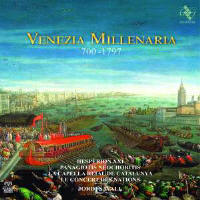Texte paru dans: / Appeared in: |
|
|
Outil de traduction ~ (Très approximatif) |
|
|
Reviewer: John
W. Barker This is the latest of Savall’s “CD Books”. There are 338 pages in the bound-book album (23 of them advertising AliaVox’s earlier releases), lavish illustrations (Venice!), and notes in six languages, plus full vocal texts and translations. The subject is the entire 11 centuries of the Venetian Republic. It was conceived as a concert program and was performed several times in 2016 and 2017. This recording comes from performances at Fontefroide Abbey, Salzburg, and Utrecht in July and October 2016.The program is chronological. Key historical dates are given, and pegged to them—but not usually relevantly—are 37 musical selections. 7 are contributed by Neochoritis’s Greek choir: ponderous liturgical renditions burdened with excess ison (drone) and miked at a distance for blurred and boring effect. Savall’s “Eastern” musicians contribute some highly speculative examples of Orientalism. Virtually all of the other selections are affected to one degree or another by Savall’s relentless arranging. (If a gamba won’t do, try drums.) Particularly traduced by all that are Medieval pieces by Marcabru and Dufay. Among Renaissance items, Jannequin’s ‘Battle of Marignano’ is drummed to death, though a Psalm by Goudimel and a Hebrew motet by Salomone Rossi emerge pretty well unscathed. Worst of all, to represent Mozart’s visit to Venice, Savall takes the “Turkish” Rondo of Piano Sonata 11 and arranges it into a cartoonish travesty of a pseudo-Turkish march. What is omitted, though, is often as striking as what is included. We get a taste of Andrea Gabrieli, but nothing of Giovanni. Rosenmuller is represented, to be sure, and Vivaldi fills a tiny and minor slot. But for Monteverdi we have nothing less than the complete Combattimento di Tancredi e Clorinda, in a rather bland performance. At the end, we have some curious representations of the peripheral French scene, with a couple of songs from the French Revolution, and then a hash of Luigi Bordese’s nostalgia-trip French cantata, which sets new words to separate movements of Beethoven’s Seventh and Fifth Symphonies! Between these are some 18th Century Carnival songs.
Against the music, the book sets groups of essays, by languages. There are good if somewhat superficial historical essays by John Julius Norwich, Judith Herrin, and Lucette Valensi, plus a final one by Silvie Mamy that discusses the musical selections. So what does it all amount to? Well, go through the book: it will give you some idea of Venetian history. But don’t bother with the discs: they will give you little idea of the rich musical dimensions of Venice’s stupendous culture. They are barely listenable once, and you are not likely to want to return to them. In sum, this is one of Savall’s weakest, most ineffective CD Books.
| |
|
|
|
|
Cliquez l'un ou l'autre
bouton pour découvrir bien d'autres critiques de CD |
|




